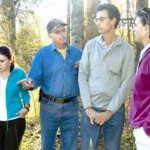Members of the Oceola Fish and Game Club invited Anna Warwick Sears (PhD), the Water Stewardship Project Director for the Okanagan Basin Water Board, to tour the Vernon Creek water system on October 11.
Representing the club were Ron Taylor and Rick Simpson, and accompanying Sears was stewardship project assistant Genevieve Doyle. Lorne Davies, an environmental consultant who works closely with the club was also present.
Raised in the Kootenays, Sears recently moved to the Okanagan after 13 years living in Santa Rosa, California where she was Director of Research for the Laguna de Santa Rosa Foundation.
While there, one of her major achievements was working on a task force, comprised of officials from various environmental agencies, to devise a long term plan to control the outburst of Ludwigia, a water weed that was threatening the balance of the Laguna’s ecosystem.
Realizing Sears is new to the Okanagan and that she only started her position this summer, the club felt the tour would be an ideal opportunity to get acquainted and to demonstrate its Kokanee conservation efforts. “She’s new to the area and hadn’t heard about what we’re doing,” says Davies.
The afternoon tour visited five stops along Vernon Creek: The Hiram Walker spillway, the sandbag control structure on Duck Lake, Holt’s farm, Reimche Rd, and the creek mouth at Wood Lake. At each location, the club members and Davies took turns explaining the significance of the Vernon Creek system to the Kokanee spawning cycle and their efforts to make sure it remains viable.
Taylor, a long-time conservationist, has been involved with the Kokanee project from the start. He recalls in 1988 there were only 800 that returned for the spawning season. Since then, numbers have been as high as 30,000 in some years.
“As someone who used to be involved in watershed restoration, I’m impressed with the work that’s being done,” said Sears, after the tour. “They definitely showed interest in taking the next step.”
For a grassroots operation, she is particularly impressed with the competency of the work being carried out and the fish and game club’s ability to work with the local stakeholder groups and other agencies to achieve its goals. “What they’re trying to do is communicate with different groups and levels of government,” she says. “It’s more than just lobbying, it’s showing your stuff.”
Taylor explains there are often overlaps between jurisdictional boundaries and the watershed boundaries, which leads to miscommunication amongst conservationists, government agencies and stakeholders. Rather than working together, he says these groups sometimes pull in opposite directions or do nothing at all.
As a result, the fish and game club has struggled at times to turn planning into action. It was only through direct discussion with the Okanagan Indian Band that they were able to install the temporary flow control structure at the Duck Lake outlet. This initiative was the result of a severe water shortage that would have devastated the 2004 Kokanee run. Had they gone through the government channels and application process, it would have been too late.
On a local level, Davies says the DLC‘s water budget is sufficient to operate a “source to tap” function, but does little else in the way of aquatic wildlife conservation. “It’s all top down planning,” he says. “What’s needed is concurrent bottom-up planning.”
To further their work, the fish and game club had applied for a water stewardship project grant from the water board last year. In particular, they requested funding to develop a Duck Lake watershed management plan and to carry out stream flow monitoring.
Evaporation, diversion, extraction and recharge are all factors that affect the water levels on Duck Lake; however, without a management plan, it is not possible to quantify which factors are contributing to the low water levels. “We need to measure it to manage it,” says Davies. “The idea is to have more water in the creek year round.”
However, their bid was rejected, as there were more applications than funding could provide for.
Simpson explains, this time around, they hope to gain some feedback from Sears to see how they can put their next application in a more favourable light. They also hope to demonstrate to her the need for funding by showing her the status of the local water system and how it relates to the livelihood of Kokanee salmon.
Sears agreed with the club’s notion that there is a lack of unity and focus regarding Vernon Creek, and reaffirmed a need for a watershed management plan. In order to be successful, she says a plan such as this requires firm leadership. “An organizational development has to happen,” she says.
As a plan of action, she suggested it might be best to build the plan with a smaller group at first, and then introduce it to potential stakeholders for comment and revision.

